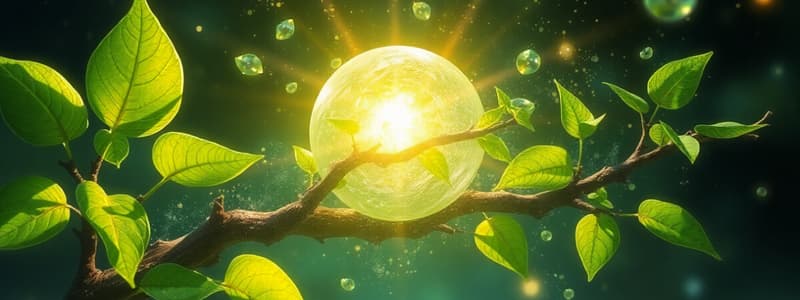Podcast
Questions and Answers
What is the primary function of chloroplasts in plant cells?
What is the primary function of chloroplasts in plant cells?
- To store nutrients and minerals
- To carry out photosynthesis (correct)
- To synthesize proteins
- To conduct cellular respiration
Which of the following best describes light-independent reactions?
Which of the following best describes light-independent reactions?
- They generate ATP directly from sunlight.
- They depend on the products of light-dependent reactions. (correct)
- They occur in the thylakoids and require light.
- They release oxygen as a byproduct.
Which statement correctly identifies a characteristic of thylakoids?
Which statement correctly identifies a characteristic of thylakoids?
- They are stacked to form grana. (correct)
- They are responsible for glucose production.
- They absorb carbon dioxide.
- They are found in the stroma of chloroplasts.
What is produced during light-dependent reactions?
What is produced during light-dependent reactions?
What happens to the light-independent reactions if no light is available?
What happens to the light-independent reactions if no light is available?
Flashcards
Photosynthesis
Photosynthesis
The process used by plants and algae to convert light energy into chemical energy stored in glucose.
Chloroplasts
Chloroplasts
Organelles within plant cells where photosynthesis takes place.
Light-Dependent Reactions
Light-Dependent Reactions
The first stage of photosynthesis, occurring on the thylakoid membranes, where light energy is used to produce ATP and reduced NADP.
Light-Independent Reactions
Light-Independent Reactions
Signup and view all the flashcards
Reduced NADP
Reduced NADP
Signup and view all the flashcards
Study Notes
Photosynthesis
- Photosynthesis is carried out by plants and algae, which are classified as autotrophic organisms.
- Animals, categorized as heterotrophic organisms, cannot photosynthesize and obtain their nutrients by consuming plants or other animals.
- The chemical equation for photosynthesis is: Carbon dioxide + water → glucose + oxygen
- Photosynthesis requires energy from light to convert carbon dioxide and water into glucose and oxygen.
- The energy stored in the chemical bonds of glucose is transferred from the light energy captured during photosynthesis.
Chloroplasts
- Chloroplasts are organelles within plant cells where photosynthesis occurs.
- Chloroplasts contain flattened membrane-bound discs called thylakoids.
- Thylakoids are stacked together to form grana, which are connected by flattened membranes called lamellae.
- The fluid inside the chloroplast is called the stroma.
Light-Dependent Reactions
- Light-dependent reactions occur on thylakoid membranes and require light.
- Light energy is used to produce ATP and reduced NADP, a hydrogen carrier.
- During light-dependent reactions, NADP is reduced to form reduced NADP.
- Water is split during light-dependent reactions, releasing oxygen as a byproduct.
Light-Independent Reactions
- Light-independent reactions happen in the stroma and do not require light directly.
- These reactions utilize ATP and reduced NADP from the light-dependent reactions.
- Glucose is produced from carbon dioxide in light-independent reactions.
- Light-independent reactions are dependent on the products of the light-dependent reactions.
- If light is absent, light-dependent reactions cease, leading to a decline in ATP and reduced NADP levels, which in turn stops light-independent reactions.
Studying That Suits You
Use AI to generate personalized quizzes and flashcards to suit your learning preferences.




